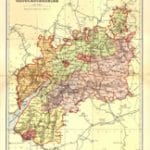North and South Gloucestershire
1782 saw the introduction of County titles to most of the Regiments of Foot in the British Army. Regiments had always recruited from far and wide in the kingdom and beyond, and, indeed, would continue to do so. Both the 28th and the 61st recruited heavily in Ireland for many years, as did many other regiments. However, the association of the various regiments with the counties of the British Isles increasingly came to mean that the army as whole began to develop the regional characteristics that were to stand it in good stead for the next two hundred or so years.
In any case, the numbering system was not abandoned. The 28th became the 28th (North Gloucestershire) Regiment of Foot and the 61st became the 61st (South Gloucestershire) Regiment of Foot. There were some difficulties and arguments as to which regiments should be allocated to which counties, for change is often painful.
Lieutenant-Colonel Morris of the 61st failed to get his way in his desire for his Regiment to be linked with Aberdeenshire, for it was there that he had first raised the 89th Foot in 1759, a regiment that had since been disbanded.
In Gloucestershire, recruiting officers for the 28th quickly took advantage of the new recruiting system, although they still had to catch deserters as well!
“Deserted from a Party of His Majesty’s 28th, or North Glocester Regiment at Tewkesbury, ROBERT STEVENS of Alderton, aged twenty, five feet eight inches high, fair complexion and light brown hair.
“Also JOHN HARRIS of Ashton, in the same County, 25 years of age, five feet six inches and a half high, dark complexion and dark brown hair. Twenty shillings reward by applying to Captain Wilson of the 28th regiment at Glocester.”
(Gloucester Journal, 30th December 1782)
Picture: Map of Gloucestershire


